henry trask & Son
henry trask & son
Aerated & Mineral Water Manufacturers
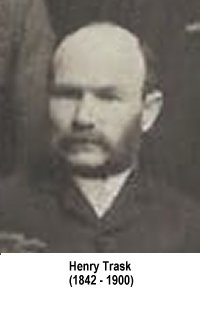 Henry
Trask was born
in 1842 in
Yeovil, the son
of whitesmith
Samuel Trask,
originally from
Odcombe, and his
wife Emma née
Samways. The 1851
census listed
the family
living at 'the
south side of
Huish' and
nine-year-old
Henry was living
there with his
parents younger
brother, two
younger sisters
and two lodgers.
By 1861 the
family were
living in
Kingston where
19-year-old
Henry was a
smith working
with his father.
Henry
Trask was born
in 1842 in
Yeovil, the son
of whitesmith
Samuel Trask,
originally from
Odcombe, and his
wife Emma née
Samways. The 1851
census listed
the family
living at 'the
south side of
Huish' and
nine-year-old
Henry was living
there with his
parents younger
brother, two
younger sisters
and two lodgers.
By 1861 the
family were
living in
Kingston where
19-year-old
Henry was a
smith working
with his father.
On 16 September 1867 at Haydon, Dorset, Henry married Susannah Williams, known as Susy, of Haydon. In the 1871 census Henry was listed as a whitesmith but was lodging in High Street, Swanage, Dorset. Susannah, at this time, was living in Cheap Street, Sherborne, with their eight-month-old son John William, a cousin and a lodger. Susannah described her occupation as a locksmith. In the 1881 census Henry and Susannah were both living in Cheap Street, Sherborne, with their ten-year-old son John and nine-year-old son William. Henry listed his occupation as 'Smith & Gasfitter'.
Henry began his mineral water business in 1881.
By 1891 Henry and Susannah had moved to Yeovil and Henry was advertising in Whitby's Yeovil Almanack Advertiser of that year as 'Trask & Son, Mineral Water Manufacturers'. The 1891 census listed Henry and Susannah, their two sons and a cousin called Mary living in Middle Street in what the census enumerator listed as 'M. W. Manufy', in other words a mineral water manufactory. Henry listed his occupation as 'mineral water manufacturer' and his son John listed his occupation as 'mineral water bottler' while his other son William was listed as a grocer's assistant.
|
In the 1891 edition of 'Where to Buy' Henry Trask's business was given the following description -
Mr H
Trask,
For many years this business has been held in high repute in Yeovil and the neighbouring towns, and in each of its various departments, Mr Trask has achieved a success. For pic-nics, garden parties, fetes and outdoor celebrations of all kinds, he supplies tents of all sizes, and maintains a stock equal to a strong demand. He is also a well-known firework agent, and contracts for the supply of those artistic illuminants which, though old to-day, will never be old-fashioned. Mr Trask has also added to his stock upwards of 6,000 fairy lamps for garden illuminations, an entirely new feature in this district, while for house decoration these lamps are unequalled. He has also various designs in stock, such as emblems, &c, and those desirous of illuminating would do well to consult Mr Trask, who will give his advice free. His arrangements for firework displays, which assist so beautifully in ensuring the success of political and other fetes, flower shows. &c, are invariably attended with success, and the operations of 'letting off' being personally conducted, enjoyment to beholders and satisfaction always to his patrons is assured. After this the business takes a sharp turn; Mr Trask is to be viewed in a totally different aspect - viz., that of manufacturer of all kinds of aerated waters, and for this purpose he has arranged his premises with system and good order. This branch is worked under the personal supervision of his son, Mr J W Trask. The list of manufactures is large, and includes everything which comes under the heading of aerated waters. He uses the best and purest ingredients, employs careful and experienced men, adopts the most approved systems of manufacture, extends a personal supervision over the whole, and by this means not only succeeds in producing a superior quality, but also in maintaining a large connection, and accordingly has many regular patrons whose number is being constantly added to.
|
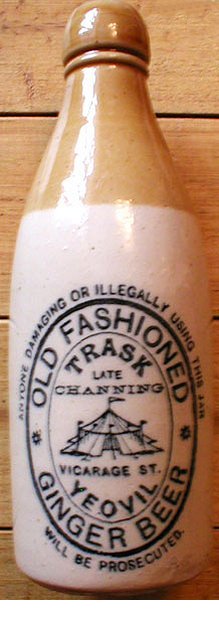 Trask's mineral
water
manufactory was
located
immediately next
door to the
gasworks and was
demolished in
1894 and the
site used to
build the
Liberal Club,
erected in 1895.
From this time
onwards the
family-run
aerated water
business moved
to
Vicarage
Street, near
Quidham Place,
taking over the
Channing bottled
water works.
Trask's mineral
water
manufactory was
located
immediately next
door to the
gasworks and was
demolished in
1894 and the
site used to
build the
Liberal Club,
erected in 1895.
From this time
onwards the
family-run
aerated water
business moved
to
Vicarage
Street, near
Quidham Place,
taking over the
Channing bottled
water works.
Henry's range of products on offer is interesting; in addition to their aerated mineral water, they produced ginger beer, ginger ale, lemonade, lemon squash, cream strawberry, raspberry, champagne cider and aerated lime juice & soda. Zolakone, hyped as being "worthy of everyone's attention", was a concentrated essence produced and supplied by Clayton & Jowett (essence manufacturers of Liverpool) and purchased by many UK mineral water manufacturers to be made up into drinks by them. 'Orange Kola' seems to be another bought-in essence - this time manufactured by ‘Orana', which was ‘prepared' by Trask's. The days when a mineral water manufacturer would brew their own ginger beer and produce their own flavourings quickly disappeared in the first years of the 20th century and most manufacturers came to rely on essences, or flavours, which became the basis of most drinks produced, but of course each local manufacturer had their own secret recipes and additional ingredients for creating their own specific drinks.
They stocked tents and marquees for sale or hire and a marquee became their trademark as seen on the bottle above. Additionally they stocked flags of all descriptions and also 3,000 fairy lamps, with lights and designs if required, suitable for illuminating houses, gardens, &c. Indispensable for garden parties, fetes and flower shows. They also proudly proclaimed they were the only proprietors of "Trask's Tea Machine and Hot Water Boiler combined" for all large gatherings.
On 8 June 1895, at the age of 22, John Trask married Bessie Cox at the Congregational Church, Yeovil. She was the daughter of carpenter William Cox and Letitia née Sparks.
Henry Trask died 27 February 1900 at Yeovil, at the age of 57. His will was administered by his son John at Taunton in April 1900. His effects amounted to £2,429 10s 5d (about £250,000 at today's value). The aerated water business, retaining the name Trask & Son, was continued by John.
The 1901 Census listed John and Bessie with their two sons; Stanley aged five and Percival aged one, together with his mother Susy, at Vicarage Street. John listed his occupation as mineral water manufacturer. In the 1911 census John and Bessie were still living at 49 Vicarage Street with John's brother William, his mother Susy, together with their three children Stanley, Dorothy, and Horace, Percival having died. The census listed John's occupation as 'mineral water manufacturer', William's occupation as 'mineral water manufacturer partner' and their mother Susy was noted as a sleeping partner in the business.
John William Trask died on 12 April 1937 and his will was proved in July at Exeter by his sons Stanley Harold and Horace Aubrey, both listed as mineral water manufacturers, and his daughter Dorothy Vera, spinster. His effects totalled £1,357 (around £78,000 at today's value).
The aerated water business was carried on by John's sons, until at least 1954.
gallery
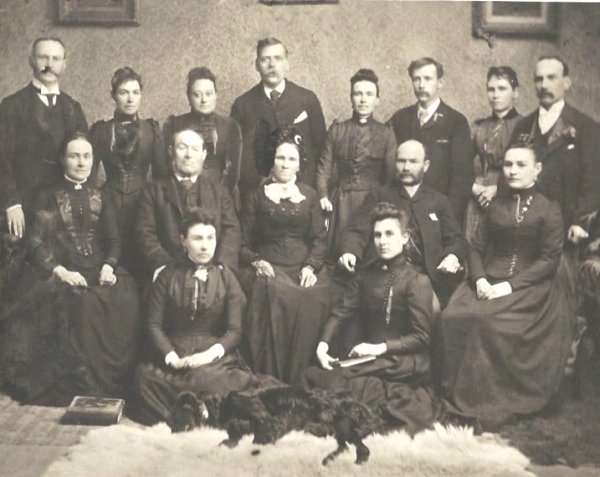
Courtesy of
Gemma January
The Trask family, thought to have been photographed at a Silver Wedding gathering around 1891. Those in the photo graph are -
Back Row -
William Johnson,
Amelia Johnson
née Trask,
Susannah,
Charles Young,
Martha Gould née
Trask, George
'Barney' Gould,
Unknown,
Frederick Trask.
Middle Row -
Elizabeth Young
née Trask,
grandfather
Samuel Trask,
grandmother Emma
Trask née
Samways, Henry
Trask, Mary Jane
'Polly' Trask.
Front Row -
Emily Warren née
Trask, Ada
Dalling née
Trask.
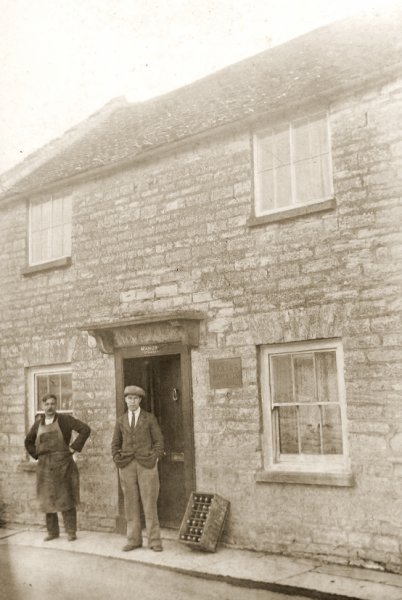
This
photograph
features in my
book "Lost Yeovil"
A postcard, probably dating to the early 1920s, showing Trask's office and factory at Manor Cottage, Vicarage Street. I'm guessing that the man by the door is John Trask.
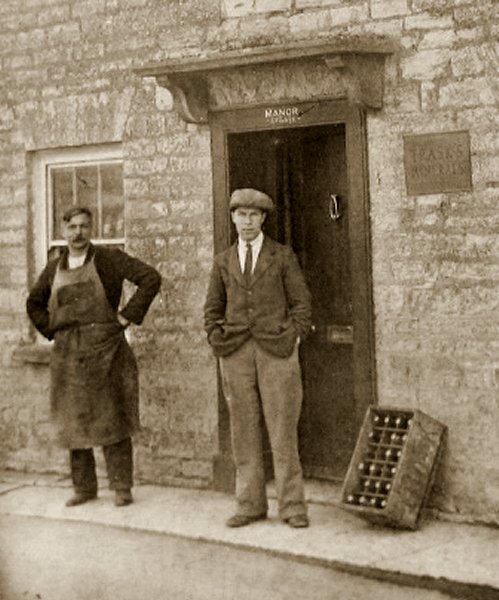
An enlargement from the previous postcard.
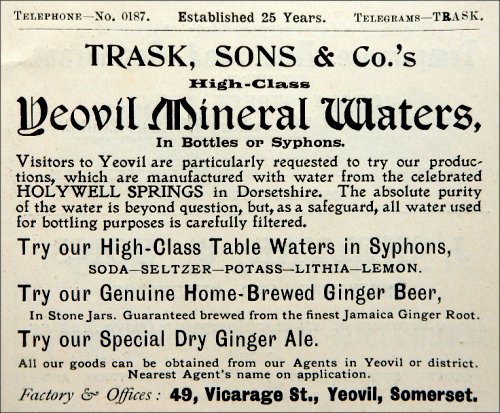
An advertisement for Trask & Sons mineral waters, and other drinks, dating to 1906.
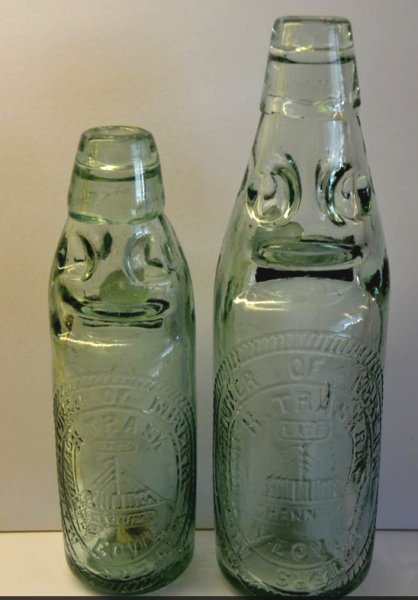
Courtesy of
Patricia Smith
Codd bottles with Henry Trask's impressed label. In 1872, British soft-drink maker Hiram Codd of Camberwell, London, designed and patented a bottle designed specifically for carbonated drinks. The Codd-neck bottle was designed and manufactured to enclose a marble and a rubber washer / gasket in the neck. The bottles were filled upside down, and pressure of the gas in the bottle forced the marble against the washer, sealing in the carbonation. The bottle was pinched into a special shape, as can be seen in the photo, to provide a chamber into which the marble was pushed to open the bottle. This prevented the marble from blocking the neck as the drink was poured.
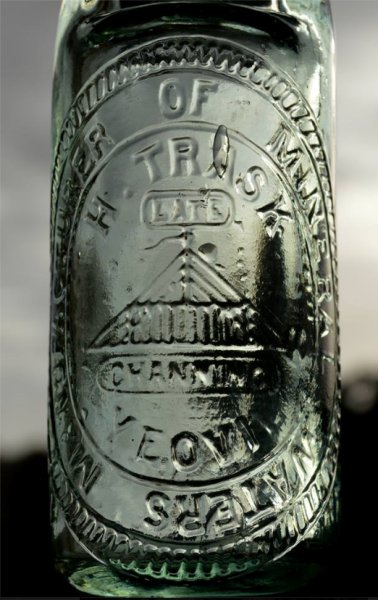
Courtesy of
Patricia Smith
Close-up of Henry Trask's impressed label in a Codd bottle.
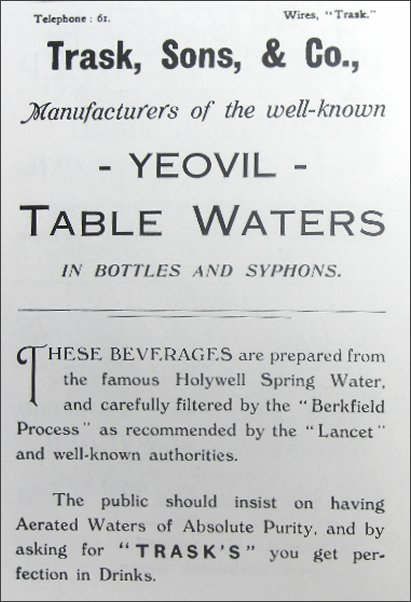
An advertisement in Whitby's Yeovil Almanack Advertiser of the mid-1920s. The "Berkefeld Process" mentioned was a water filter made of diatomaceous earth. It was invented in Germany in 1891, and by 1922 was being marketed in the United Kingdom by the Berkefeld Filter Co. Berkefeld was the name of owner of the mine in Hanover, Germany, where the ceramic material was obtained.
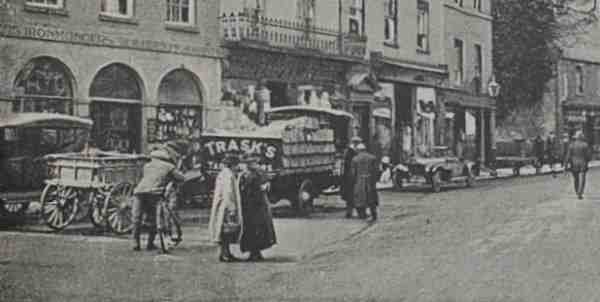
A Trask's delivery lorry delivering in the Borough during the 1920s.
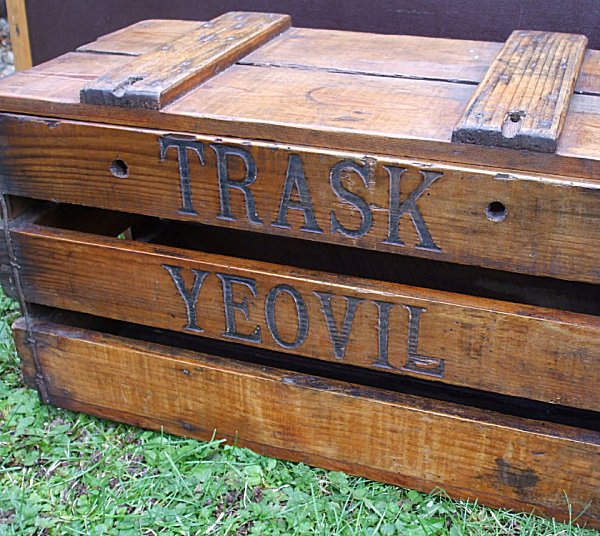
An early twentieth century wooden packing case for bottles of mineral water, etc.
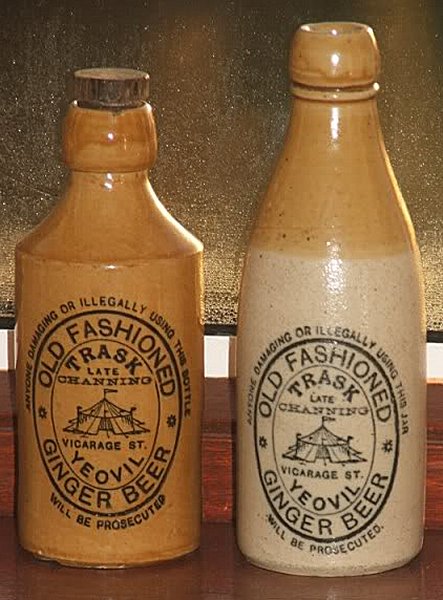
More turn-of-the-century Trask's ginger beer bottles with the marquee logo.
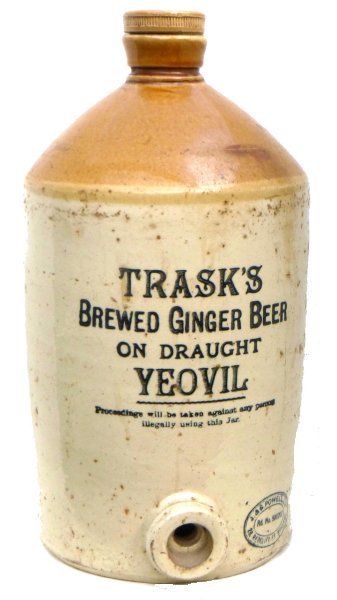
Courtesy of
Deborah Woodford
This is a 16½ high, 1½ gallon jar, made by J & B Powell Ltd of 28 Redcliffe Street, Bristol, around 1900.
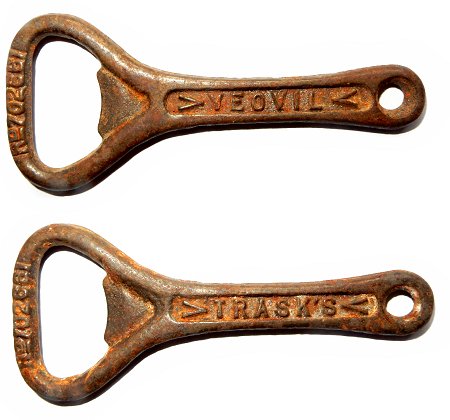
From my
collection
Both sides of a Trask's of Yeovil promotional cast iron bottle opener. Technically known as a 'Crown Cork opener', the marking 'RD 702661' dates it to between 1924 and 1936.
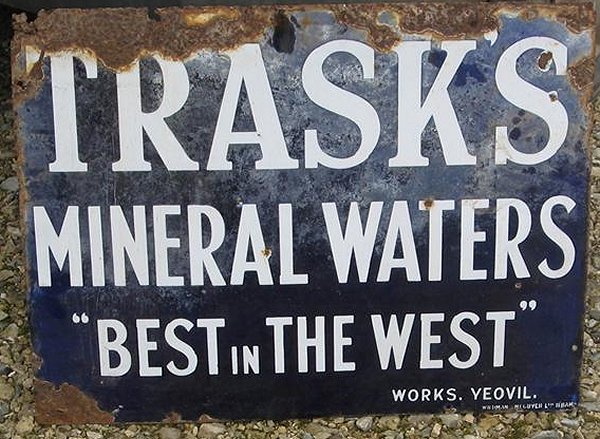
An enamel sign, probably from the 1930s.
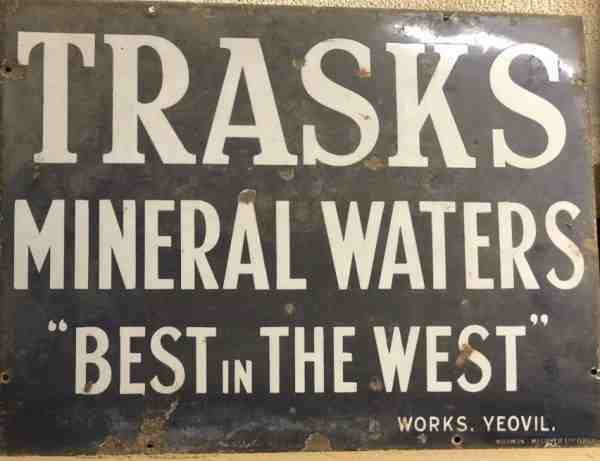
Courtesy of
Daniel Dicks
Same sign, better condition, different colourway.
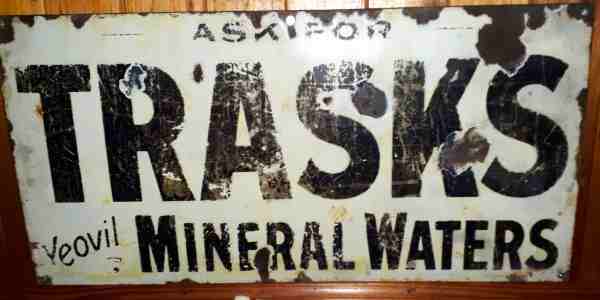
Courtesy of Tony
Rendell
Another enamel sign, probably from the same period.
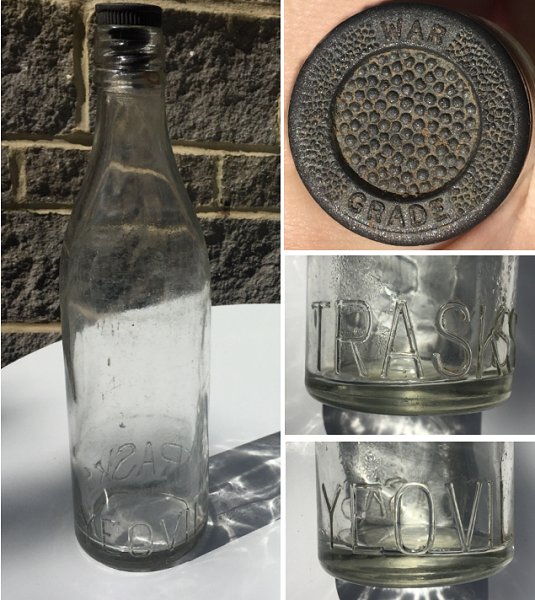
Courtesy of Alan
& Pamela Walton
A sparkling mineral water bottle of Second World War vintage - note the 'War Grade' on the top of the vulcanite / ebonite screw stopper.
It was Henry Barrett, in 1872, who invented this particular type of screw stopper – and they were subsequently used then for well over 100 years until the 1970s. Henry actually patented the design in the early 1880s, and he was also the person who designed the internal screw thread for the interior of the bottle neck. The stoppers themselves are made from hard, non-elastic, India rubber, also known as vulcanite. The process of vulcanisation involved heating rubber to 115 degrees Celsius with sulphur and linseed oil, thereby converting it into a more durable material. The stoppers are also sometimes described as being made from ebonite, which was the brand name for the vulcanised rubber and patented by Charles Goodyear in 1846.
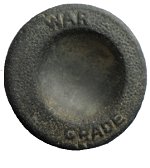 During
the war, with
rubber in short
supply, it is
possible that an
inferior
material was
used for a
while. Also, the
stoppers were
sometimes
scooped out at
the top, as in
the illustration
at left' so that
that less
material was
used. The
stoppers made in
this fashion
during the war,
were stamped
with “War
Grade”.
During
the war, with
rubber in short
supply, it is
possible that an
inferior
material was
used for a
while. Also, the
stoppers were
sometimes
scooped out at
the top, as in
the illustration
at left' so that
that less
material was
used. The
stoppers made in
this fashion
during the war,
were stamped
with “War
Grade”.
If you have more details on this particular bottle please contact me.
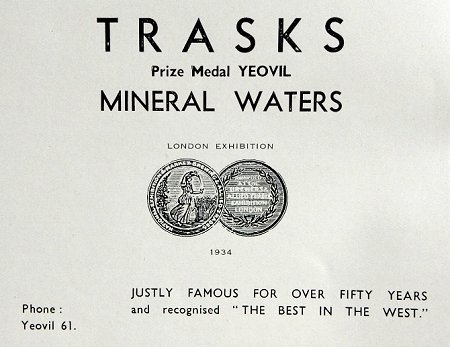
From my
collection
Trask's advertisement in the 1950 Yeovil Guide.
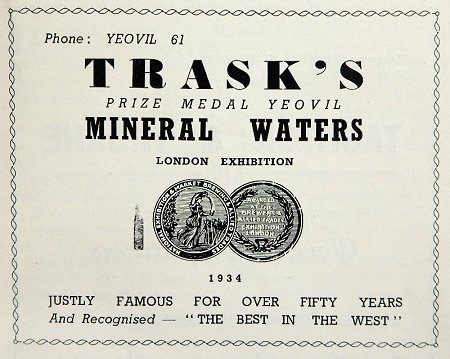
From my
collection
Trask's advertisement in the 1961 Yeovil Rural District Official Guide.
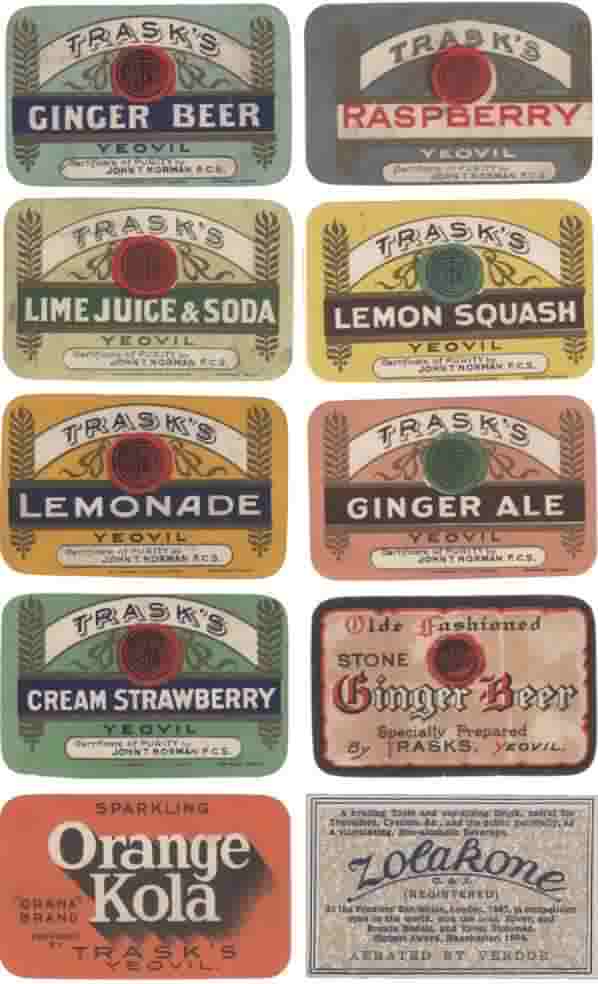
Labels courtesy
of Peter
Radcliffe